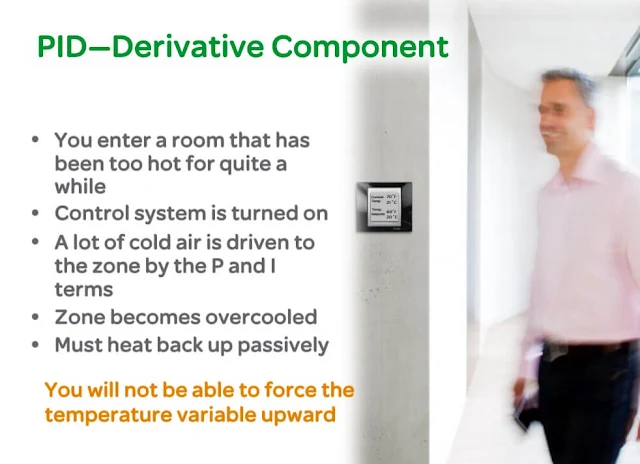Which of the following statements is true regarding the proportional control response?
The proportional response is concerned with
The integral response is concerned with
The derivative response is concerned with
On a graph of actual over time, the integral is represented by the area under the graph.
On a graph of actual over time, the derivative is represented by the slope of the line.
When is it especially useful to avoid overshooting the setpoint?
What's the value of adding the derivative?
When determining appropriate uses for P-I-D, what is the first key component to determine?
Select the appropriate response for a control situation where for every degree of temperature offset from the setpoint, the response must be increased by a fixed amount.
Recomended for you
- Proportional control is a simple and widely used method of control for many kinds of systems.
- Proportional control involves giving a response proportional to the stimulus by addressing how far from set-point the variable is.
- Proportional control follows one simple rule, “For every degree of temperature difference from the setpoint, increase the airflow by a certain amount”.
- All of the above
- None of the above
The proportional response is concerned with
- The present offset
- Accumulation of past offsets
- Prediction of future offsets
- None of the above
The integral response is concerned with
- The present offset
- Accumulation of past offsets
- Prediction of future offsets
- None of the above
The derivative response is concerned with
- The present offset
- Accumulation of past offsets
- Prediction of future offsets
- None of the above
On a graph of actual over time, the integral is represented by the area under the graph.
- True
- False
On a graph of actual over time, the derivative is represented by the slope of the line.
- True
- False
When is it especially useful to avoid overshooting the setpoint?
- In a building where cooling towers are employed to increase the refrigeration effect. If the cooling tower is overused due to overshooting the setpoint, there will be an impact on the water bills and fan energy consumption.
- In a building where cooling is enabled but heating is disabled. If the zone is overcooled due to overshooting the setpoint, users will have to wait for the space to heat back up passively.
- In a building where waste heat recovery is used to provide domestic hot water. If the zone is overheated due to overshooting the setpoint, insufficient waste heat may be available.
- None of the above
What's the value of adding the derivative?
- The derivative term changes the total response if the actual value is falling or rising quickly. This makes the change more gradual and helps avoid overshooting the setpoint.
- The derivative calculation increases the range of inputs for which the controller output does not change, even if the input changes.
- The derivative term changes the total response if the actual value has been away from setpoint for a long time. This makes the change even faster in order to achieve setpoint in a timely manner.
- All of the above
When determining appropriate uses for P-I-D, what is the first key component to determine?
- Cost—how much you can spend
- Time—how long the control system takes to detect a change
- System placement
- None of the above
Select the appropriate response for a control situation where for every degree of temperature offset from the setpoint, the response must be increased by a fixed amount.
- Proportional
- Integral
- Derivative
- Floating
Summary of Building Controls V – Proportional and PID Responses course.
- Proportional control is a simple control method that provides a response proportional to the stimulus.
- It is calculated from the difference between the actual and set-point. An integral term can be added, which is driven by the amount of time that the measured variable has been offset from the setpoint.
- On a graph of actual versus setpoint over time, it is calculated from the area under the graph.
- A derivative term can also be added, which is driven by the rate of change of the measured variable. This is useful to prevent overshoots.
- On a graph of actual over time, it is calculated from the slope of the line.
- Finally, also we identified which response was appropriate to a slow responding system, which response was appropriate for a moderate and fast responding system.
Recomended for you
- MCQ on Building Controls I: An Introduction to Building Controls | Primo Engineering
- MCQ on Building Controls II: Control Sensors | Primo Engineering
- MCQ on Building Controls III: Introduction to Control Loops | Primo Engineering
- MCQ on Building Controls IV: Two Position and Floating Responses | Primo Engineering
- MCQ on Active Energy Efficiency Using Speed Control Course
- MCQ on Measurement and Verification Including IPMVP Course
- MCQ on A Comparison of AC and DC Power Distribution in the Data Center Answer
- MCQ on HVAC Thermodynamic States | ENERGY UNIVERSITY COURSES
- Building Controls V – Proportional and PID Responses | Primo Engineering
- تفاصيل مسابقة جامعة شنايدر للطاقة 2020 "Energy university championship "لطلاب هندسة كهربائية

